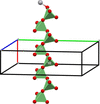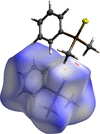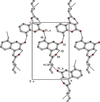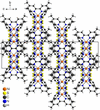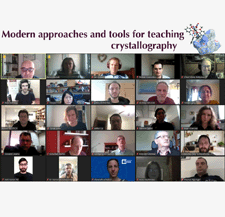issue contents
July 2024 issue

Cover illustration: The compound tricarbonyl[η4-6-exo-(triphenylphosphino)cyclohepta-2,4-dien-1-oneiron(0) tetrafluoroborate, synthesized during a Course-based Undergraduate Research Experience (CURE), crystallizes as a dichloromethane hemi-solvate. The crystal structure features an intricate 3D supramolecular network of hydrogen bonds, C—H⋯π and Y—X⋯π (Y = B, C; X = F, O) interactions that entrap the solvent molecules. See: Wong, Reinheimer, Nataro & Griffith [Acta Cryst. (2024). E80, 746–750].
research communications
Download citation


Download citation


The crystal structures of 2-[1′-(carboxymethyl)-4,4′-bipyridine-1,1′-diium-1-yl]acetate tetrafluoroborate, C14H13N2O4+·BF4− or (Hbcbpy)(BF4), and neutral 1,1′-bis(carboxylatomethyl)-4,4′-bipyridine-1,1′-diium (bcbpy), C14H20N2O8, are reported.
Download citation


Download citation


3-Phenyl-2-(thiophen-3-yl)-2,3-dihydro-4H-pyrido[3,2-e][1,3]thiazin-4-one (C17H12N2OS2, 1) and 2-(1H-indol-3-yl)-3-phenyl-2,3-dihydro-4H-pyrido[3,2-e][1,3]thiazin-4-one 0.438-hydrate (C21H15N3OS·0.438H2O, 2) crystallize in space groups P21/n and C2/c, respectively. The asymmetric unit in each case is comprised of two parent molecules, albeit of mixed chirality in the case of 1 and of similar chirality in 2 with the enantiomers occupying the neighboring asymmetric units. Structure 2 also has water molecules (partial occupancies) that form continous channels along the b-axis direction.
Download citation


Download citation


The crystal structures of the title compounds, which arose from the same reaction, consist of discrete complexes in which the cobalt cations are either in a CoN2O3 trigonal–bipyramidal or a CoN2O4 octahedral coordination.
Download citation


Download citation


The title salt features N—H⋯Cl and C—H⋯Cl cation-to-anion hydrogen bonds and complementary anion-to-cation Cl⋯π interactions.
CCDC reference: 2347766
Download citation


Download citation


The synthesis, crystal structure and a Hirshfeld surface analysis of tris{N,N-diethyl-N′-[(4-nitrophenyl)(oxo)methyl]carbamimidothioato}cobalt(III) are described.
CCDC reference: 2361104
Download citation


Download citation


In the title compound, molecules are connected by Hg⋯O interactions. The 1:1 complexes pack in zigzag chains where they stack via two alternating stacking patterns, TPPM(cyclic trimeric perfluoro-o-phenylenemercury)–TPPM, and FLA(flavone)–FLA. The shortened F⋯F, CH⋯F and CH⋯π contacts consolidate the crystal structure.
CCDC reference: 2360864
Download citation


Download citation


The cystallization and capture of hexachlorothallium within the phosphotunsgate and caesium chloride matrix is described.
CCDC reference: 2361833
Download citation


Download citation


The zwitterionic, isomeric, title compounds, Gly-Met and Met-Gly are methionine-containing dipeptides, which show very different conformations in the solid state.
Download citation


Download citation


In the four main structures, the anions and cations are connected by aurophilic contacts, hydrogen bonds C—H⋯halogen and (in two cases) C—H⋯Au contacts. In the by-product without pyridinic N coordination a N—H⋯N bond dominates the packing pattern supported by Br⋯Br, H⋯Br, and Au⋯Br contacts.
Download citation


Download citation


This study describes the synthesis, characterization, and Hirshfeld surface analysis of a small organic ammonium bromide salt. The analysis reveals a torsion angle of −64.8 (2)° between the ammonium group and the bromine substituent.
CCDC reference: 2362029
Download citation


Download citation


The title complex possesses pseudo-octahedral geometry where one face of the octahedron is occupied by three carbonyl ligands and the other face is occupied by one sp2 nitrogen atom of the sulfonamide group and two sp3 nitrogen atoms of the dien backbone.
CCDC reference: 2362252
Download citation


Download citation


The crystal structure of tricarbonyl[η4-6-exo-(triphenylphosphino)cyclohepta-2,4-dien-1-one]iron(0) tetrafluoroborate is described. The two independent tricarbonyl[η4-6-exo-(triphenylphosphino)cyclohepta-2,4-dien-1-one] iron(0) cations and their corresponding anions form dimers, which constitute the asymmetric unit of the structure within the (100) plane.
CCDC reference: 2362680
Download citation


Download citation


The title compound contains infinite linear zigzag vanadate (V2O6)2−chains, constructed from corner-sharing VO4 tetrahedra, running parallel to the a axis.
CCDC reference: 2291372
Download citation


Download citation


The title compound, C8H11PS, which melts below room temperature, was crystallized at low temperature. The P—S bond length is 1.9623 (5) Å and the major contributors to the Hirshfeld surface are H⋯H, S⋯H/H⋯S and C⋯H/H⋯C contacts.
CCDC reference: 2362349
Download citation


Download citation


The crystal structure of the molecular complex between 2-(allylthio)pyridine and 1,2,4,5-tetrafluoro-3,6-diiodobenzene, which exhibits an N⋯I halogen bond, has been determined at 100 K.
CCDC reference: 2362511
Download citation


Download citation


The crystal structure of 1,2,3,4-tetrahydroisoquinolin-2-ium (2S,3S)-3-carboxy-2,3- dihydroxypropanoate monohydrate (orthorhombic crystal system, space group P212121, Z = 4) features an intricate two-dimensional hydrogen-bond network.
CCDC reference: 2362561
Download citation


Download citation


In the title compound, the dihedral angle between the coumarin ring system and the pentanoate ring is 36.26 (8)°. A short intramolecular C—H⋯O contact is observed.
CCDC reference: 2363131
Download citation


Download citation


In the crystal structure of the title compound, Ni(NCS)2(C6H7N)2 (C6H7N = 4-methylpyridine), the NiII cations are in an octahedral coordination and are linked by pairs of anionic ligands into corrugated chains in which the cations show alternating all-trans and cis–cis–trans coordination geometries. Upon heating, the title compound transforms into Ni(NCS)2(C6H7N), which is isotypic to its Cd analog as proven by a Rietveld refinement.
CCDC reference: 2363246
Download citation


Download citation


In the crystal, molecules are linked by intermolecular N—H⋯O, C—H⋯O, C—H⋯F and C—H⋯Br hydrogen bonds, forming a three-dimensional network. In addition, C—H⋯π interactions connect molecules into ribbons along the b-axis direction, consolidating the molecular packing.
CCDC reference: 2362911
Download citation


Download citation


In the title molecule, the pyrazolopyrimidine moiety is planar with the methylsulfanyl substituent lying essentially in the same plane, whereas the benzyl group is rotated well out of this plane giving the molecule an approximate L shape.
CCDC reference: 2363971
Download citation


Download citation


A reaction between cucurbit[6]uril (CB6) with an excess of Pr(NO3)3·6H2O lead to the isolation of new mononuclear complex [Pr(CB6)(NO3)(H2O)5](NO3)2·9.56H2O (1), which crystallizes in the P21/n space group. The asymmetric unit of 1 contains two crystallographically independent [Pr(CB6)(NO3)(H2O)5]2+ complex cations, four nitrate counter-anions for charge balance and 19.12 interstitial water molecules. The coordination environments of the PrIII ions in 1 are formed by two carbonyl O atoms from bidentate cucurbit[6]uril units, two oxygen atoms from the bidentate nitrate anion and five water molecules.
CCDC reference: 2362791
Download citation


Download citation


The two MnII atoms in the complex display a different coordination number, viz. five with a distorted trigonal–bipyramidal Cl3N2 and six with a distorted octahedral Cl3N2O coordination set.
CCDC reference: 2364423
Download citation


Download citation


Despite the facile interconversion of its conformers in solution, 4-benzyl-1H-pyrazole adopts a chiral crystal structure (space group P21). Its 3,5-diamino derivative, however, crystallizes in the centrosymmetric space group P21/c. In both crystal structures, the aromatic moieties are organized in alternating bilayers in which they stack in parallel columns in two orthogonal directions, and the pyrazole units form catemer motifs by N—H⋯N and N—H⋯π hydrogen bonding, respectively.
Download citation


Download citation


Accessible from basic aqueous solutions, a new monoclinic polymorph of the diuretic chlorothiazide is described.
CCDC reference: 2364581
Download citation


Download citation


The crystal structures of two chromium(II) acetate complexes with N-heterocyclic carbene coligands were determined.

 journal menu
journal menu























